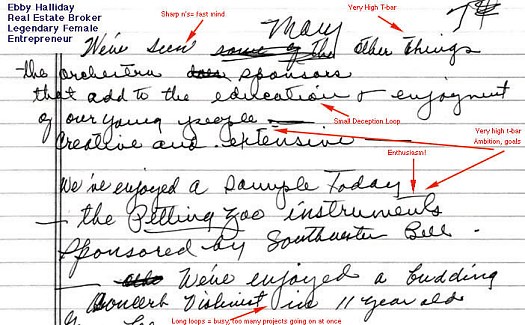 |
| http://www.italicus.co.uk/images/analysis3.jpg |
o http://graphicinsight.co.za/background.htm
o In 300 B.C., Aristotle states, “ "Spoken words are the symbols of mental experience and written words are the symbols of spoken words. Just as all men have not the same speech sounds, so all men have not the same writing," showing the relationship between handwriting and personality.
o In 1000 B.C., Japanese scholars state that character related to the way a man traces his bars according to the thickness, length, rigidity or suppleness.
o In 1611 Prospero Aldorisio writes a book that describes handwriting analysis.
o Camilo Baldi also describes handwriting analysis in 1622 however his book is not officially published until 1625.
o Abee Michon published books that coined the name of “graphology” in the late 1800s. Crepieux Jamin later published a series of books in other languages that classified the idea into a comprehensive system.
o From 1893 to 1907 Alfred Binet conducts rejected research.
o During the 1920’s Dr. Ludwig Klages applies the gestalt theory to graphology, advances theories of rhythm and “form level,” and vastly expands the scope of graphology in Germany.
o In 1929 Milton Bunker founds The American Grapho Analysis Society that teaches Graphoanalysis into two studies: Graphoanalysis and Holistic Graphology. Klara G Roman, a scholar, publishes books still considered foundation for contemporary American Holistic graphology.
o In 1939, Hans J Jacoby, writes a book that brings the European method of analysis to England and America.
o Charlie Cole organizes Handwriting Workshop Unlimited for students of Graphoanalysis, that included ideas of Klara Roman. In 1960, all participants were expelled, which led to the formation of the American Handwriting Analysis Foundation and later the American Association of Handwriting Analysts.
o In 1966, Robert Heiss organizes handwriting into “Space, Form, and Movement” and states that all writing characteristics can be arranged under the categories.
o In 1972, the American Handwriting Analysis Foundation and the American Association of Handwriting Analysts want to form a single organization.
o in 1976, the American Handwriting Analysis Foundation and the American Association of Handwriting Analysts form to create the Council of Graphological Societiesm.
o In the mid 1990’s, the Starzecpyzel Daubert hearing stated that forensic document examination “does not employ rigorous methodology,” which encourages the continuation of scientific methods and standards in forensic handwriting analysis.








